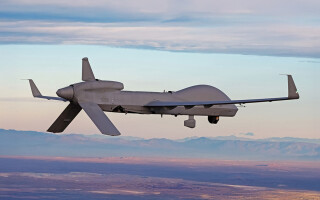AI in deployed systems
StoryJune 11, 2025

By applying electronics thermal-management expertise with a range of proven module and chassis-level cooling technologies – such as conduction, forced air, air-flow-through (AFT), and liquid-flow-through (LFT) – advanced processing and communications solutions can operate in harsh extended temperature environments and deliver the new capabilities enabled by artificial intelligence and machine learning (AI/ML) to the tactical edge.
Military system integrators are exploring how they can best leverage the power of artificial intelligence (AI) at the edge of the battlefield. When considering use cases for AI in aerospace and defense, people naturally first think of examples they are familiar with – such as generative AI – as exemplified in a ChatGPT application. With generative AI, the user can ask a computer a question or request it to do a task, after which the computer will search through its library of data and return an answer or complete the requested action. Generative AI has become a prominent feature used to simplify Internet searches in web browsers from Google and Microsoft.
When it comes to military use, AI is not limited to generative AI or large language models (LLM), but is also being used for a wide variety of applications, such as mission readiness, image recognition and target detection, autonomy, and predictive maintenance. The U.S. government is using AI to help locate and identify adversaries, leveraging the technology’s ability to find patterns and identify things far better than can be accomplished with the human eye alone. With AI-enabled health and usage monitoring systems (HUMS), data can be analyzed to predict maintenance issues, informing operators when to pull equipment out for maintenance before a problem becomes critical. This condition-based maintenance approach, compared with regularly scheduled maintenance, can prevent costly, premature replacement of equipment and significantly improve platform mission readiness.
Putting machines in the line of fire
For autonomous platforms, such as unmanned aircraft, maritime vessels, and ground vehicles, AI helps keep humans out of harm’s reach by instead putting machines in the line of fire. Autonomy is a burgeoning growth area being funded by the U.S. and foreign governments, for which technology is quickly evolving. Historically, to achieve true self-driving vehicles, for example, it has been necessary to deploy high-end data center-class AI processors. In a traditional data center, however, that amount of performance requires the use of racks full of power-hungry equipment. One of the major challenges facing defense system designers is how to deliver high-performance embedded computing for AI at the tactical edge while at the same time optimizing size, weight and power (SWaP). Examples of some current U.S. Department of Defense (DoD) programs of record funded to drive deployable AI capabilities in the battlefield include Project Maven (AI target detection system), the U.S. Army’s Tactical Intelligence Targeting Access Node (TITAN) ground station, Human-Machine Integrated Formations (HMIF), XM30 fighting vehicle program, Robotic Combat Vehicle (RCV), and the U.S. Air Force’s Collaborative Combat Aircraft (CCA) programs. (Figure 1.)
.jpg)
[Figure 1 ǀ Concepts of the uncrewed fighter aircraft YFQ-42A (bottom) and the YFQ-44A are illustrated. The aircraft are designed to leverage autonomous capabilities and crewed-uncrewed teaming to defeat enemy threats in contested environments. U.S. Air Force artwork/courtesy General Atomics Aeronautical Systems, Inc. and Anduril Industries.]
Spoiled for choice
Embedded systems engineers currently have a wide range of AI-enabling device types to choose from, including technology from NVIDIA, Intel, AMD, Microchip, and more. These devices include discrete central processing units (CPUs), graphics processing units (GPUs), field-programmable gate arrays (FPGAs), or integrated system-on-chip (SoC) or system-on-module (SoM) devices that combine general-purpose processing with AI acceleration engines in a single package. A good example of the latter is NVIDIA’s Jetson/IGX processors that pair ARM processors with Tensor/CUDA-core GPUs. Similarly, Intel and AMD have robust x86 CPUs + GPU SoC devices in the Core, Atom, and EPYC product lines, with some SoCs also integrating dedicated AI neural processing units (NPU). AMD also has powerful adaptive system-on-chip (ASoC) devices in its Versal line that combine FPGA logic, DSP engines, Arm CPUs, and AI cores in a single device. Further, radiation-tolerant RISC-V CPU-based SoCs from Microchip, capable of advanced machine learning (ML) and time-sensitive networking (TSN), are now entering the market to enable the deployment of AI applications in space.
Recently, Intel has publicly shared its strategies to integrate AI into all of its processors intended for use at the edge, thus addressing low- and mid-level inferencing needs. For high-end AI training and inference workloads, system designers generally rely on GPU architecture from NVIDIA. As reported during 2024, NVIDIA held a 94% market share for GPUs in the datacenter market. NVIDIA is now one of the most valuable companies on the planet because of its very strong GPU/AI story.
Cooling strategies
Keeping high-power AI workload servers cool is a major issue. Traditionally, fans have been used, but as performance has risen, so have power requirements: Currently, approximately 60kW to 120kW per rack for NVIDIA Blackwell GPU architecture. In response, the increase in power has driven adoption of advanced cooling approaches at the data center, such as liquid cooling and immersion-cooling technology. Similarly, to enable deployment of power-hungry sensor processing devices at the tactical edge, new cooling methods beyond conduction or air cooling are now being deployed. Within the SOSA [Sensor Open Systems Architecture] and VITA standards communities, approaches for liquid-flow-through (LFT) and air-flow-through (AFT) cooling applied to OpenVPX architectures have substantially increased the amount of watts per card slot that can be effectively cooled, enabling the use of ~300W boards in applications that would have historically been limited to plug-in cards (PICs) that dissipate a maximum of ~150W.
At NVIDIA’s most recent annual GTC event, CEO Jensen Huang cited NVIDIA’s advancements to support 800 Gb optical networking at the data center, speeds far exceeding the capabilities of today’s embedded systems at the edge. For deployed VPX systems, the data throughput bottleneck has traditionally been the backplane connectors and optical transceivers, since VPX RT3 connectors and extended temperature optics are limited today to 100 Gigabit (100G) across a backplane. For example, VPX RT3 connector technology has been foundational for the Fabric100 VPX ecosystem to support 100 Gigabit Ethernet (GbE) and Gen4 PCIe interconnects, which is critical for integrators and systems architects to build today’s most advanced modular open systems approach (MOSA)-based sensor processing and AI/ML inferencing solutions.
100G and beyond …
To go beyond 100G performance in VITA-based edge systems, an emerging new standard called VITA 100 will utilize a new MultiGig HD connector from TE Connectivity that supports double or even four times the current backplane throughput, with support for up to 400GBase-KR4 (up to 53 Gbaud per lane) and PCIe 6.0 interconnects. VITA 100 is likely to be adopted by early 2026. In data centers, while the maturity of PCIe 6.0 and higher-speed optical interconnects are providing strong capabilities for AI processing systems, state-of-the art commercial components are constrained to narrow temperature ranges and benign environments.
For today’s advanced OpenVPX systems, VITA 46 technology supports up to 28 Gbaud per channel, where four-lane 25 Gbaud interfaces support 100 Gbps throughput. Optics are not limited by VITA standards, but optical transceiver technology is limited when operating across extended temperature ranges. As optics technologies evolve, higher speed interfaces will be possible for extreme edge environments. Several SOSA aligned modules, such as the VPX3-536 and VPX6-476, feature blind-mate VITA 66.5 Style D optical connectors to support high data rate 100G optical interfaces over the VPX backplane.
Low latency is key
Latency is another important system-architecture consideration for enabling AI at the edge. When users are dependent on time-sensitive sensor data, they require the lowest latency possible in order to process, ingress, and egress data inputs and outputs. One approach for reducing latency is to eliminate bottleneck data flows through the CPU’s memory, which can introduce detrimental delays to system performance. Facilitating faster data flows, some GPU technologies and network adapters are now capable of porting remote direct memory access (RDMA) memory over PCIe or Ethernet. For network-based applications, the RDMA over Converged Ethernet (RoCE) network protocol can enable remote direct memory access across an IP network. NVIDIA GPUs support GPU Direct RDMA over PCIe so users can interface sensor data over the PCIe expansion plane without having to go through host CPU memory. When high-speed sensor data can be processed without delay, faster data inferences can be applied through AI models to keep warfighters safer and more effective in their missions.
In addition to optimizing throughput between cards and sensors, system integrators also need to ensure resilient, secure network connectivity between boxes and edge platforms, to enable the safe sharing of situational-awareness data gleaned from AI inferencing in the battlefield. Compared to a fixed data center, AI processing at the tactical edge presents vastly different communications due to mobility and environmental conditions. This fact is compounded by distrust/disconnection from public infrastructure. AI processing nodes should be architected to mitigate contested environments and protect against attempts by adversaries to hack, spoof, jam, and tamper with sensitive mission data.
While it would be ideal for warfighters to have access to the same high-performance processing capabilities that are available at a data center and directly port enterprise-level software applications into their embedded systems, physical SWaP and ruggedization constraints for electronics deployed at the edge may drive important tradeoff decisions. These tradeoffs can be somewhat offset, however, through the use of new highly efficient AI accelerator engines and software optimization of machine learning (ML) algorithms. There is a common sentiment that “Today’s AI is the worst you’ll ever use,” implying that AI technology is rapidly evolving and improving, and that we should not assume that it is as powerful or as efficient as what we’ll be deploying next year, next week or even tomorrow. To make today’s AI models work more efficiently and faster at the tactical edge, it’s essential to optimize the hardware and software they run on.
Further, as AI applications become better able to take advantage of the latest floating-point format accuracies – including FP4 – and leverage simulation environments to refine model training prior to deployment, computational demands at the edge can be significantly reduced. For software, that means instead of reinventing the wheel or starting with a bloated software model, smaller AI software footprints can be utilized and optimized to enable the warfighter to re-purpose and do more with the same piece of hardware. NVIDIA now considers itself a software company (with more software engineers than any other role), underscoring the importance of the extensive software libraries and frameworks it supports for AI enablement today. These software tools can be readily ported from enterprise rack servers and then optimized for embedded edge machines.
The archetype for military applications is to look to the state-of-the-art in the commercial world and determine how to adapt it. The embedded systems industry is certainly following that approach by improving cooling, interconnect speeds, and data-flow efficiency, while optimizing software and leveraging access to the highest performance devices from AI chip vendors with the best performance per watt to enable AI processing. By applying the electronics industry’s thermal-management expertise with a range of proven module and chassis-level cooling technologies – such as conduction, forced air, AFT, and LFT – advanced processing and communications solutions can operate in harsh extended-temperature environments and deliver the new capabilities enabled by AI/ML to the tactical edge.
Mike Southworth is Senior Product Line Manager, C5ISR, for Curtiss-Wright Defense Systems. He has 20+ years of experience in technical product management and marketing communications leadership roles. Mike holds an MBA from the University of Utah and a Bachelor of Arts in Public Relations from Brigham Young University.
Curtiss-Wright Defense Systems https://www.curtisswrightds.com/
Illustration courtesy Curtiss-Wright.






